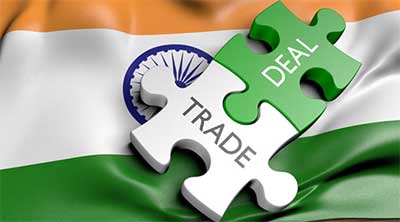Date: 17/11/2022
Relevance: GS-2: Bilateral, regional and global groupings and agreements involving India and/or affecting India’s interests.
Key Phrases: Free Trade Agreements, Department of International Trade, Strategic Objectives, International Agreements Committee, Constitutional Reform and Governance Act, of 2010, department-related parliamentary committees.
Why in news?
- To achieve the export target of $2 trillion by 2030, India is going the whole hog on free trade agreements (FTAs).
- But India negotiates most FTAs behind closed doors with very little information about the objectives and processes followed and negligible scrutiny.
Free Trade Agreement:
- It is a pact between two or more countries, where the objective is to remove trade barriers between imports and exports and ensure hassle-free trade relations as far as possible.
- Under a free trade agreement, countries offer preferential trade terms and tariff concessions to each other.
FTAs with India:
- So far, India has signed 13 Free Trade Agreements (FTAs) with its trading partners, including the 3 agreements, namely India-Mauritius Comprehensive Economic Cooperation and Partnership Agreement (CECPA), India-UAE Comprehensive Partnership Agreement (CEPA) and India-Australia Economic Cooperation and Trade Agreement (IndAus ECTA) signed during the last five years.
FTA negotiations in the U.K.:
- Strategic Objectives:
- In the U.K.:
- The Department of International Trade (DFIT), U.K., publishes a policy paper laying down the strategic objectives behind negotiating an FTA and why it is important for the U.K. to have an FTA with a particular country.
- This policy paper is fairly detailed listing the specific advantages of signing an FTA such as the economic gains expected, distributional impacts, the environmental impact, and the labour and human rights dimensions of the FTA.
- In India:
- No such document is produced publicly that makes a case for signing an FTA and assessing its impact on the environment and society at large.
- The Commerce Ministry — the nodal body dealing with FTAs — on its website provides the bare minimum information about FTA negotiations.
- Stakeholder consultation:
- In the U.K.:
- The policy paper that the DFIT publishes also contains the inputs and responses received by various stakeholders such as businesses, non-governmental organizations, and others.
- Furthermore, the policy paper also explains the government’s view on specific suggestions.
- In India:
- The Commerce Ministry also undertakes stakeholder consultations and inter-ministerial meetings but there is no public record of these discussions and the government’s response to the concerns of stakeholders.
- Parliamentary scrutiny:
- In the U.K.:
- The strategic objectives identified by the government for signing an FTA are scrutinized by the U.K. Parliament.
- This job is performed by the International Agreements Committee (IAC) of the British Parliament.
- The IAC hears expert witnesses on the FTA, critically examines the government’s strategic objectives for each FTA under negotiation, and offers key recommendations wherever it finds gaps in the government’s approach. The U.K. government then responds to these recommendations.
- In India:
- There is no mechanism for such parliamentary scrutiny of the executive’s actions during the FTA negotiations.
- India’s parliamentary system allows for department-related parliamentary committees that discuss various topics of importance and offer recommendations.
- However, the Parliamentary Standing Committee on Commerce (PSCC) rarely scrutinizes the Indian government’s objectives behind negotiating and signing an FTA.
- Mechanism for ratification of treaties:
- In the U.K.:
- Under the Constitutional Reform and Governance Act, of 2010, the executive has to lay down a treaty before the British Parliament for 21 sitting days with an explanatory memorandum before ratifying it.
- This allows Parliament to be apprised of the treaty the executive is going to ratify.
- In India:
- There is no mechanism for any role of Parliament in the ratification of treaties including FTAs.
- Entering into treaties and matters incidental to it such as negotiations, signing, and ratification is within the constitutional competence of Parliament.
- But, Parliament in the last seven-plus decades has not exercised its power on this issue, thus giving the executive unfettered freedom in negotiating, signing, and ratifying treaties including FTAs.
Need for a law on entering treaties:
- India should take a leaf out of the U.K. book and develop a law on entering treaties including FTAs.
- This law should have the following parts:
- Outlining strategic objectives publicly:
- The executive should make a clear economic case outlining its strategic objectives publicly for entering into negotiations for a treaty such as an FTA.
Consult the stakeholders:
- The executive should be under an obligation to consult all stakeholders, respond to their concerns, and make this information publicly available.
- Committee for scrutiny:
- The Indian Parliament should constitute a committee on the lines of the U.K.’s IAC that will scrutinize the strategic objectives behind entering into an FTA.
- Placing FTA before parliament:
- The executive should place the FTA on the floor of Parliament for a certain duration, allowing Parliament to debate it, before ratifying it.
Conclusion:
- While the executive’s constitutional prerogative of entering into an FTA or international treaties, in general, is indisputable, this power should be exercised in a manner that makes the executive answerable.
- After all, an integral facet of democracy is to hold the executive to account for its actions.
- It should be no different for negotiating international treaties including FTAs.
Source: The Hindu
Mains Question:
- Q. What is a free trade agreement (FTA)? What are the issues related to the transparency of the mechanisms for entering international treaties, including FTAs, and what international practices can India adopt to improve the transparency of the process? Discuss.







